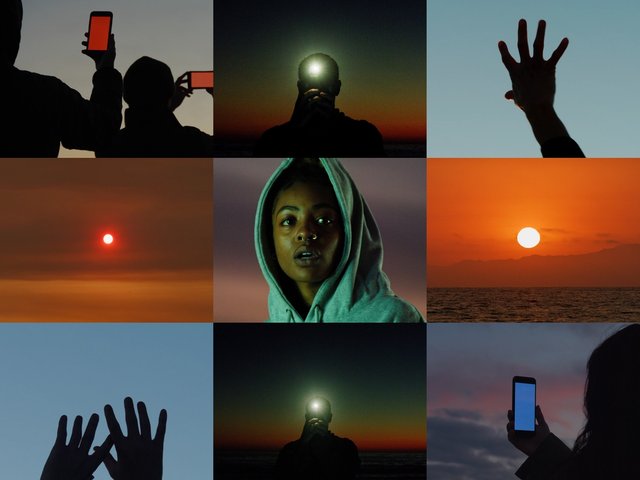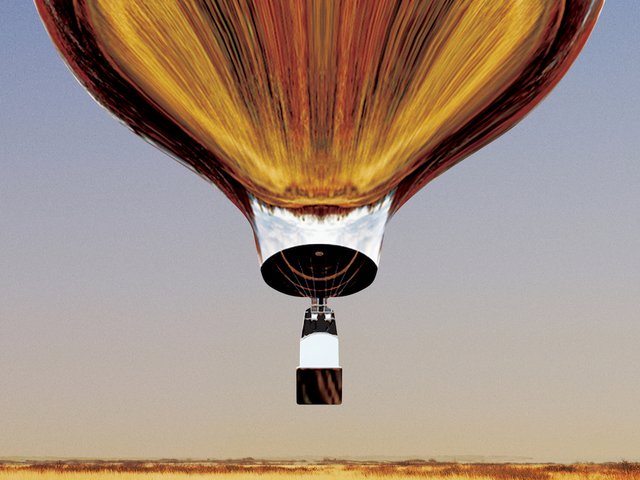Time must run differently for Doug Aitken. When I talked to him on the phone, the Californian artist had recently wrapped up his idealistic, collaborative, experimental project Station to Station, which took him on a cross-country trip aboard an LED-streaked train with dozens of other artists and musicians, stopping at ten points along the way to create spontaneous happenings and performances. But there is no rest for the artist; Aitken has already started work on another major project. When I call, the ventilation system in the space where he is working drowns out the ringtone of his mobile phone.
“When you called earlier, I wasn’t able to answer the phone because there’s this workshop down the street from my studio that I go to, which allows me to work on a piece with my hands in this factory space,” he says. “That’s as simple as it gets almost… going into a space where you’re carving something and there’s no one there, a dirt floor and bars of lights, and you’re making a sculpture and nothing more. It balances everything out, it empowers you to work in a way where nothing becomes too precious so you can allow yourself to take greater risks.”
This shifting of gears from simple to complicated, frenetic to serene, is at the centre of Aitken’s practice, which results in work ranging from video and sound installations that can cover entire museum façades (note the plural), to text-based sculptures, to happenings that bring the viewer face-to-face with lightning-tongued auctioneers, a professional whip-cracker and acrobatic pole-dancers.

“I’ve always felt most at home when there are multiple things happening and growing,” Aitken says. He describes his process as organic and nonlinear. “Metaphorically, you can almost look at it as a tree and say that you have these roots—we all do, there’s certain things that we’re drawn towards or questions that come up over and over—and you recognise that there are these fundamental things that are the core of who you are and what you make. But at the same time, this tree can have different branches that can go very, very far in one direction.”
Aitken says he likes to allow such concepts to develop in their own way, rather than stick to what came before. “You let an idea live, grow and push until it becomes very distinctly its own, as opposed to trying to frame something within your body of work.” Perhaps this is why his work takes so many different forms and always seems to be evolving into something new. “It’s like the Galapagos, it’s Darwinistic.”
In the beginning Aitken was born in Redondo Beach and lives and works a few miles up the coast in Venice. But after art school he spent most of the 1990s in New York, where the art market was reeling from a post-bubble collapse. “I wanted to be in a situation that had agitation,” he says. “It was an interesting period because I moved exactly when the art world was crashing—galleries were closing all around.” Aitken did not know anyone in the city, but started showing at spaces such as the artist-run commercial gallery AC Project Room and the New Museum. “My work was very much about experimentation, it was about trying to find a new language. [With] the people I ran into at that period, we would do shows in squats or unregulated places or storage rooms. There was a sense that there wasn’t capitalism in existence for a while.”
“You let an idea live, grow and push until it becomes very distinctly its own”
These early days of experimentation led to broader visions, and soon Aitken was watching for a storm to hit the site of the Jonestown massacre in Guyana (monsoon, 1995), cutting through bureaucratic red-tape to film high-security diamond mines in the Namib Desert (diamond sea, 1997), and getting a look behind the scenes of Bollywood (into the sun, 1999). Curators and gallerists started to pay attention and his career was made in 1999 when he won the Golden Lion at the Venice Biennale for his immersive multi-channel installation electric earth, 1999, part of Harald Szeemann’s first run at curating the international exhibition.
The work, which centres on a young man who dances his way around an abandoned city at night, is still one of Aitken’s most recognised pieces (see below). It went on view at the Nam June Paik Art Center in Seoul last month in a solo show celebrating Aitken winning the institution’s art prize (until 2 February 2014). “If you connect with a work of art, it’s almost as if you have a set of photographic memories, an experience of your relationship with that work,” he says. “Some work trails off and you forget about it but others almost become part of your DNA, they keep coming back. It’s strange when it’s your own work, like electric earth.”
Aitken has been reviewing many of these early works for a monograph coming out with publisher Rizzoli in March next year. “It was the first time in my life that I had to look back,” he says, and although he describes the experience as a little awkward, he also says it “was almost like walking into this room and there are all these really old friends you haven’t talked to in a long time: ‘How are you doing, remember when we were in the Namib desert?’ ‘Yes, I remember that, the van got stuck when we were filming.’”
The here and now For Aitken, it all seems to come back to the question of time and how it is experienced. One way of defining what art can be, he says, is its potential to engage. “What I value is an encounter where I’m brought into the present, whatever it is that I’m seeing, whether it’s a work of art [like a painting] or a performance,” he says.
In his own work, however, this pull towards the present is manifested through immersive installations and Allan Kaprow-inspired happenings that bring the viewer into the work. “The language of doing something live, like being involved in a happening, is very natural to me. It’s similar to what you come across when you’re filming something,” he says. “You have this very finite moment where something has to happen, it’s not something you can come back to tomorrow. I’m very attracted to the idea of projects that have a sense of urgency, that are time-based, via the process of making them or the idea that they’re being made for a specific encounter.”
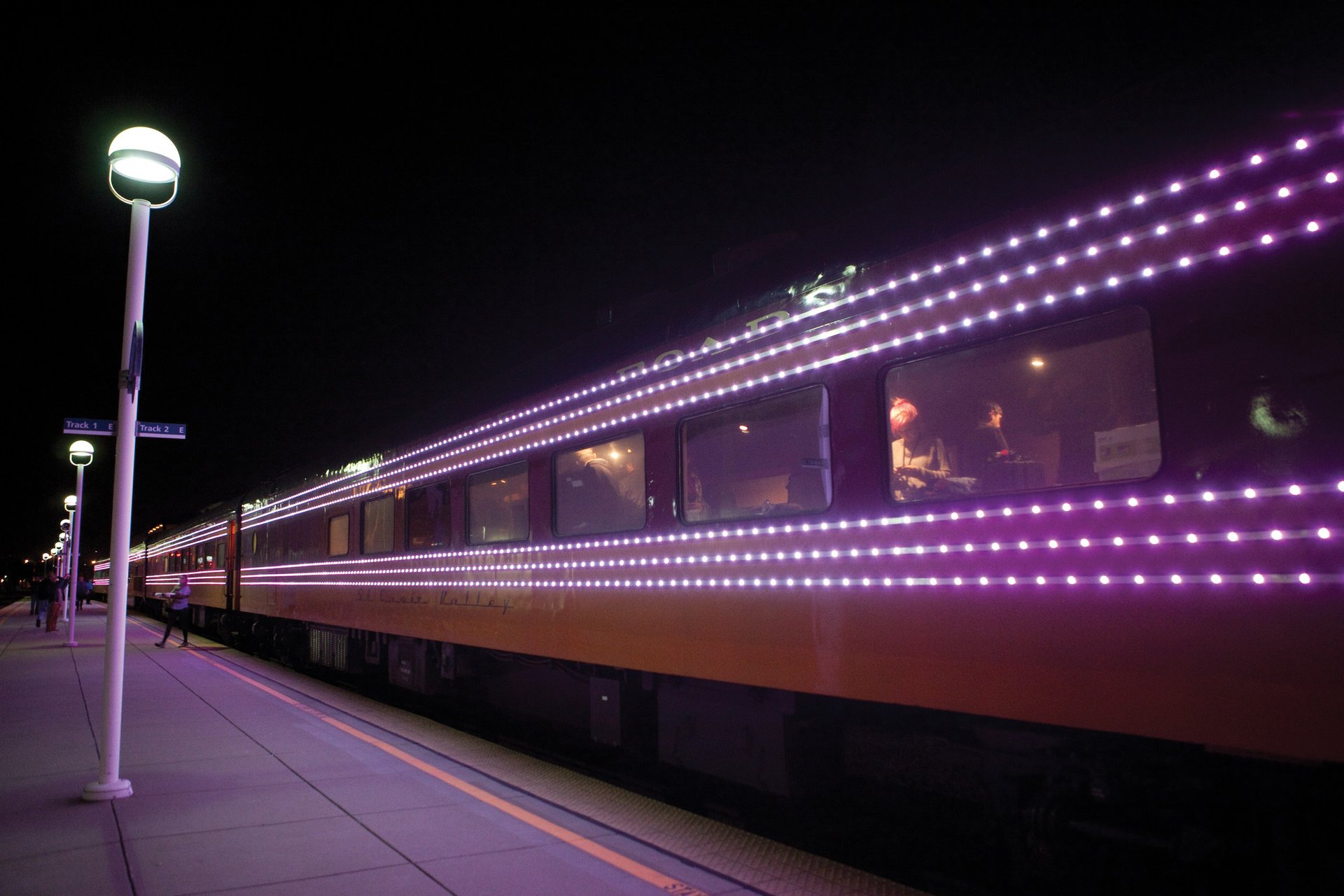
His most recent project, Station to Station, is the ultimate expression of this idea. The “nomadic happening” was born of out a desire to “create something that is always moving, always changing”. It also came out of a need to take art and performance out of its usual habitat—the gallery, the museum, the concert hall—and give the artists and musicians that participated a chance to experiment with something new. So, you end up with the veteran visual artist Ed Ruscha forgoing his usual paintings and drawings to cook up a cactus omelette served to a few hundred people in the Arizona desert, or Olafur Eliasson creating a kinetic drawing machine that used the train’s own movements to scribble out a piece over the 3,000-mile journey. “These are people who we think we know their work, and then they’re able to use Station to Station as a platform for making something totally different,” Aitken says.
He also sees it as a kind of manifesto, a call to arms. “In some ways, I wanted Station to Station to be the roots of a different movement that was artist driven and was not confined by media or place. The project was born out of necessity, it wasn’t a whim. There is a need for new platforms, new situations for contemporary culture, to find our voices outside of the restrictions that surround us.” Aitken stresses the importance of experimentation, with its attendant risks and failures. “If we become satisfied with the standardisation that we see within art, then how does art retain its value? How does it continue to grow simultaneously with other aspects of culture and not slow down and become perhaps more irrelevant and capitalistic?”
Station to Station has had mixed reviews. Some criticised the overt branding of the clothing label Levi’s, which footed the bill for the entire project (estimated in the seven-figure range), while others revelled in the chance to see major performers such as Beck and Patti Smith up close and personal. Tickets to attend the one-day stops quickly sold out in most cities. The feat of organising a three-week art event on wheels, with different players getting on and off along the way, is impressive in itself. “I think it was successful in that it happened. It’s a miracle,” Aitken says. “Every person that made something for this did so on their own, because they believed in it and they were committed to it.”
What’s to come While Station to Station trundled across the US, Aitken’s on-board production team put out a steady stream of short videos documenting some of the events and artists’ installations, as well as peeks at life on the train, but more is planned. Aitken says that, in addition to a film, he’d like to create work that can be given away and shared. But don’t expect to see him driving another locomotive. “I’d never do that. If we do something else, it could be an opera house in the Amazon, it could be a barge in the Mediterranean. Station to Station needs to be a forever changing journey,” he says. “And I would like other people to do things like this on their own and in their own way. I hope that we can see other templates evolve.”
Meanwhile, Aitken is already on to his next show at the Sundance Film Festival in January, which will feature his free-standing structure The Source, 2012. The circular structure, first seen at the Liverpool Biennial last year, serves as a walk-in pavilion for Aitken’s four-minute interviews with creative people such as Devendra Banhart, William Eggleston, Jacques Herzog, Mike Kelley, Philippe Parreno, Paolo Soleri, Tilda Swinton, Ryan Trecartin and Jack White (many of the names reappeared on the Station to Station roster). This work came out of personal conversations that Aitken has had over the years. “You have dinner late at night with someone and you’re talking about why they’re doing what they’re doing and sometimes you hear these things that would be so pointed, a crystallisation of an idea, it would be so pure,” he says.
And after that? Like his work, it all depends on one very important thing. “I just don’t have enough time, there’s never enough time in a day,” Aitken says. “It’s all a chess game really, it’s always moving and changing.” But one thing remains constant for him. “I can’t really imagine living without making things of some form.”
Digest: Doug Aitken Biography
Born: Redondo Beach, California, 1968
Education: BFA, Art Center College of Design, Pasadena, 1991
Lives and works: Los Angeles and New York
Represented by: Regen Projects, Los Angeles; Victoria Miro Gallery, London; Galerie Eva Presenhuber, Zürich; 303 Gallery, New York
Sel ected exhibitions: 2013 “Electric Earth”, Nam June Paik Art Center, Seoul; “Station to Station: a Nomadic Happening”, New York, Pittsburgh, Minneapolis/St Paul, Chicago, Kansas City, Lamy/Santa Fe, Winslow, Barstow, Los Angeles, Oakland/San Francisco; “100 Yrs”, 303 Gallery, New York 2012 "Moving City", Arles; “Song1”, Hirshhorn Museum and Sculpture Garden, Washington, DC; "The Source", Tate Liverpool 2011 "Altered Earth", Serpentine Gallery, London; "I Am in You" Sammlung Goetz at Haus der Kunst, Munich; “Black Mirror”, Deste Project Space, Hydra, Greece 2010 "The Artist’s Museum", Museum of Contemporary Art, Los Angeles; “House”, Regen Projects, Los Angeles 2009 “Migration (Empire)”, St Louis Art Museum 2007 “Sleepwalkers”, Museum of Modern Art and Creative Time, New York 2000 Whitney Biennial, Whitney Museum of American Art, New York 1999 “dAPERTutto”, Venice Biennale 1997 Whitney Biennial, New York
Key works song1, 2012, Hirshhorn Museum and Sculpture Garden, Washington, DC
Aitken wrapped the rounded exterior of the Smithsonian’s contemporary art museum in a 360-degree projection last year that played from sunset to midnight for nearly two months. For the soundtrack, he enlisted some of his regular musical collaborators, such as Beck, Björk and Devendra Banhart, to cover the 1934 ballad “I Only Have Eyes For You”.
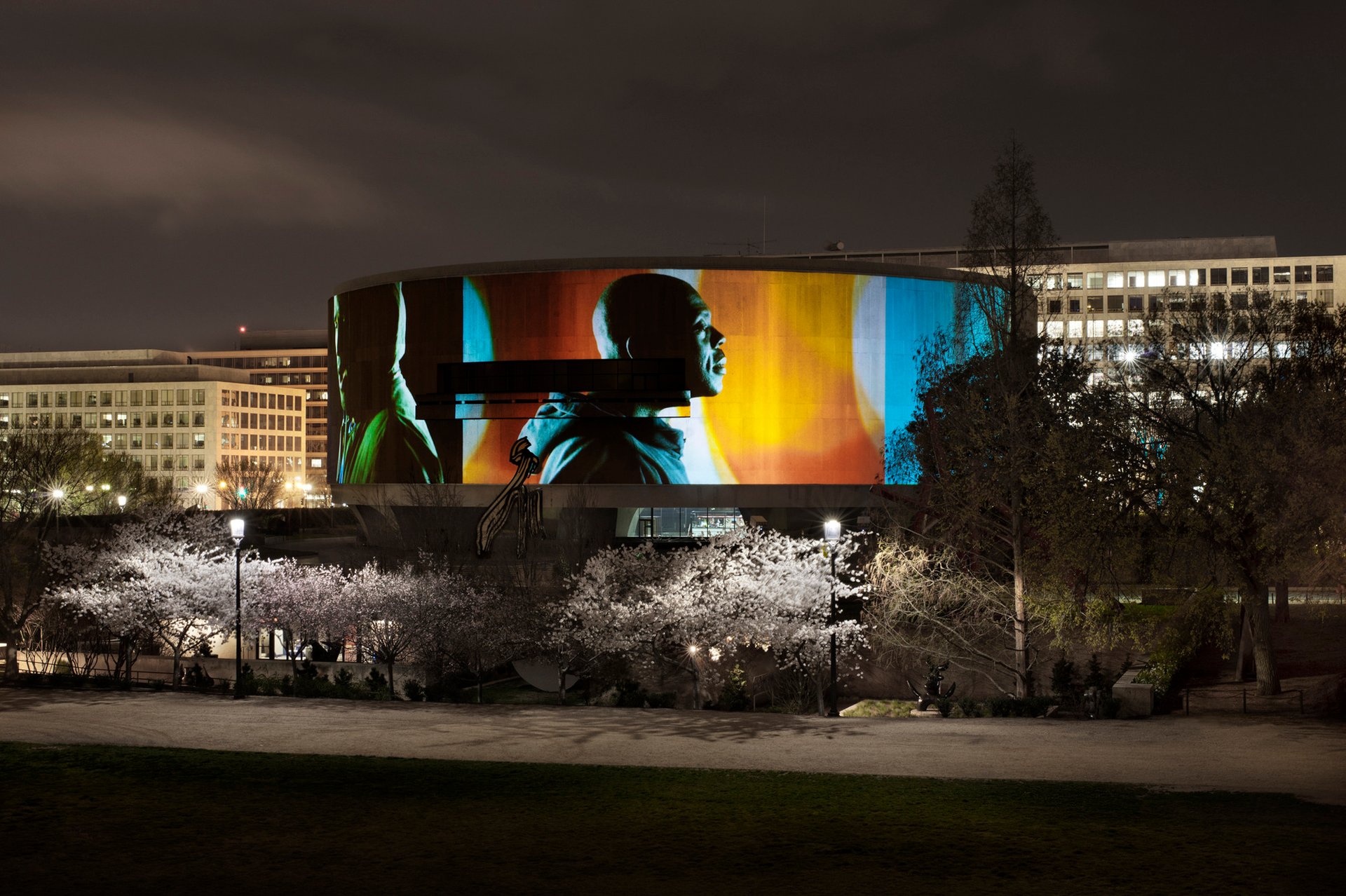
sleepwalkers, 2007, Museum of Modern Art, New York
Not long after MoMA reopened in its new home in Manhattan, the walls surrounding its sculpture garden and street entrances became an outdoor theatre for one of Aitken’s most star-studded films to date. The work presented a faceted view of rushing city life, with characters played by Tilda Swinton, Donald Sutherland, Ryan Donowho, Cat Power and Seu Jorge.
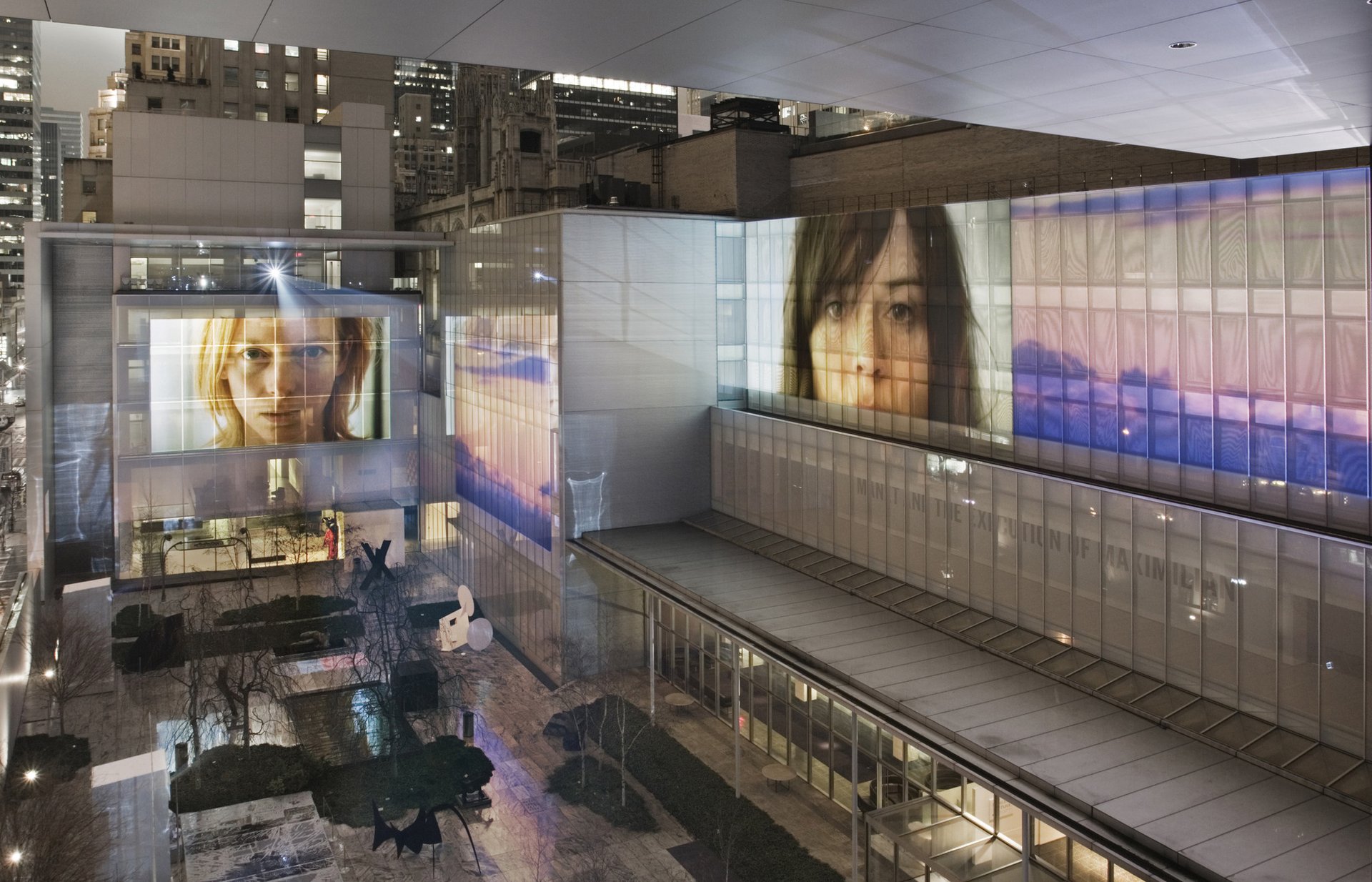
electric earth, 1999, Venice Biennale
The work that propelled Aitken into the spotlight when it won him a Golden Lion award at the Venice Biennale seems relatively modest compared with his later productions. A lone young man struts and dances his way across the empty urban sprawl. Sometimes simple is best though, with the piece still engaging new audiences nearly 15 years later.



